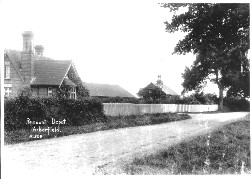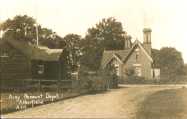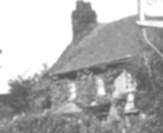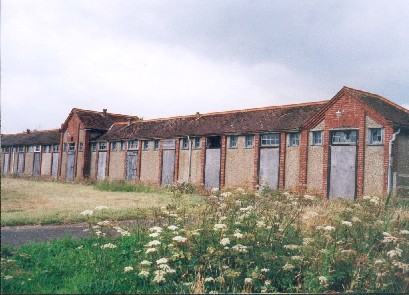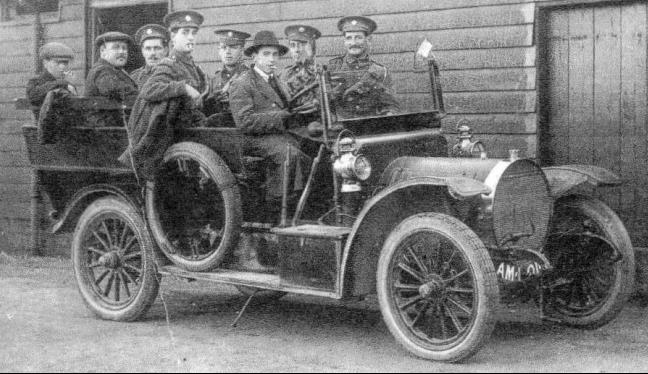
|
Arborfield
|
|
Memories
Related sites:
A Notice appeared on August 8th 1914 in the 'Reading Mercury': REMOUNT DEPOT, ARBORFIELD CROSS, WANTED In a NATIONAL EMERGENCY a Large Number of
Grooms at Arborfield Remount Depôt, Near Reading. Wages £1 1s (twenty
one shillings) a week. For the present Tent Accommodation will be
provided and a Mess will be instituted at the Depôt.
|
Arborfield and the Army Remount Service This page contains quotations from a booklet published in 1984 and written by Colonel Bob Hume, based on articles in the 1980 and 1981 R.E.M.E. Journals. The material is Crown Copyright, and is reproduced by permission of the R.E.M.E. Museum.'The problem of supplying the Army with remounts in time of war was not grasped until 1887 when the necessary reserve of horses was created by the introduction of a scheme for the registration of privately-owned animals. Under this scheme an owner could offer a number of his horses to the Army for purchase, at a fixed price, in the event of war. In return, the owner received a subsidy towards the cost of keeping the animals that had been accepted for registration.'
'The Remount Department was a slender organisation. Purchasing was the responsibility of two Assistant-Inspectors of Remounts; a third controlled the Registration Scheme. There were two remount depots: the old Remount Establishment at Woolwich and a second in Dublin. Woolwich retained its affiliation with the artillery and engineers and the depot in Dublin provided a centre for purchasing activities in Ireland, where most cavalry remounts were obtained. The depots received newly-purchased animals and held them until they were seen to be fit for issue to a unit. Remounts were not trained at the depots. Most had been broken-in before they were purchased and the further schooling that they needed in ceremonial and tactical work was given after they had joined their regiments. 'The depots were commanded by Staff-Captains of the Remount Department and manned by soldiers seconded from the cavalry. In 1891, the responsibility for manning the depots was transferred to the Army Service Corps, who formed a remount company at each depot. Command of the remount depots remained a preserve of the combatant Arms. The association between the Remount Service and the Army Service Corps continued until the Second World War when the Remount Service and the Veterinary Service were amalgamated.' [...] [The booklet described in detail the activities of the Remount Service during
and after the Boer War.] 'The Peace Establishment of the Remount Service was also increased. Two additional depots were formed to expand the base organisation from which remounts would be supplied to the Army overseas in time of war. Since these two depots were intended solely for service at Home, they were staffed largely by civilians. The locations selected for the depots were Melton Mowbray and Arborfield.' 'The parcel of land originally acquired for the Arborfield Remount Depot was part of the Bearwood Estate owned by the Walter family. It was an area of some 200 acres enclosed by Langley Common Road, by the line of the old Reading Road (now marked by Bramshill Close, Whitehall Drive and Sheerlands Road), by the tree-lined track which still marks the southern boundary of the Garrison and by the limit of the rising ground to the east of Biggs Lane. In later years the eastern boundary was marked by a strip plantation of fir trees, which offered horses at grass some protection from the extremes of weather. Only a vestige of this plantation now remains: the Sandhurst-style barracks have taken its place.
'Biggs's Farm became the headquarters of the Depot with its main gate on the old Reading Road; this entrance is now the junction of Rowcroft Road and Sheerlands Road. The outbuildings included a quadrangle of wooden stabling and sheds which became the 'Main Yard' of the depot. Ellis's Farm provided the isolation lines where animals with contagious diseases could be segregated from the rest of the stock.' [...] ... 'The veterinary officer was assisted in his duties by the farrier-major of the depot: Farrier Quarter-Master Serjeant Clark of the 6th Dragoon Guards (The Carabiniers). When he left the Service some years later, William Clark took the licence of 'The Swan' in Arborfield Cross. 'The quartermaster, veterinary officer and farrier-major were apparently the
only serving soldiers at the depot. The rest of the staff, probably no more than
fifty in all, were civilians. The quartermaster and farrier-major lived within
the Depot: the quartermaster in Old Biggs's Farm and the farrier-major in White
C [...] '[In spring 1914] the acreage at Arborfield was increased. A strip of farmland was purchased beyond the eastern boundary of the Depot; it stretched from Langley Common Road to Commonfield Lane and it included Langley Common Farm, known today as Langley House. Temporary stabling was constructed to accommodate a further 600 horses and, in keeping with the practice observed at that time, the horse lines were dispersed throughout the Depot to prevent the spread of infectious disease. [...] The design of this stabling was rather like a Dutch Barn: two open-sided rows of stalls protected by a roof. It was cheap to construct and it served to accustom the remounts to the conditions they would soon experience on active service. [...]' 'In April 1914, Captain Barry left Arborfield to take up his appointment in North America. He was succeeded by Major G. H. Badcock, OBE. George Badcock had recently retired from the Indian Army Service Corps where he had been employed with the Indian Remount Department. He rejoined the Service as the Superintendent of the Depot and remained in charge, as a brevet lieutenant-colonel, until 1919. [...]' '[...] During the course of the war, almost 600,000 animals and as many again were imported into England from overseas. In addition, the Remount Commissions shipped a substantial number of animals direct to the various theatres of war. 'The character of the Arborfield Remount Depot changed sharply on the outbreak of the war. The staff who were of an age for military service were enlisted in the Army and overnight a military hierarchy emerged. The foremen, for example, appeared as serjeants in the Army Service Corps. The influx of requisitioned animals was such that additional grazing had to be taken at Arborfield Court, Carters Hill, Swallowfield Court and elsewhere. During the war, several thousand animals passed through the Depot. [...] '[...] it gained renown as the home of a very successful concert party: the 'Zepps'. This group of talented young soldiers, who appeared on the stage in a costume symbolic of the Zeppelin, provided a variety of entertainment; their serious recitals in the village church were as well attended as their light-hearted performances in the canteen of the Depot. [...]'
'Much valuable background information on the Army Remount Service was generously provided by Mr. C. A. Potts of the Ministry of Defence Library. Mr. M. F. Shearn, Clerk to the Arborfield and Newland Parish Council, kindly allowed photographs from his archives to be reproduced and also sought out reminiscences from his acquaintances who remember the Remount Depot; in particular, Miss V. Gutteridge and Mr. G. Bentley who provided most interesting material'. Arborfield and the Army Remount Service, 1904-1937 - Colonel R. Hume,
B. Sc. (Eng.), C.(Eng), M.I.E.E. Back to WW1 Remount Depot Page
|
| |
|
Any Feedback or comments on this website? Please e-mail the webmaster |
